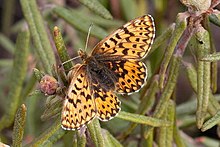| Freija fritillary | |
|---|---|

| |
| In central Russia | |
| Scientific classification | |
| Domain: | Eukaryota |
| Kingdom: | Animalia |
| Phylum: | Arthropoda |
| Class: | Insecta |
| Order: | Lepidoptera |
| Family: | Nymphalidae |
| Genus: | Boloria |
| Species: | B. freija |
| Binomial name | |
| Boloria freija (Becklin in Thunberg, 1791) | |
| Synonyms | |
| |
Boloria freija, the Freija fritillary, is a butterfly of the family Nymphalidae with a circumboreal distribution. It occurs in bogs and tundra. Its range includes Northern Europe to the north of 60° N, occasionally more southern locations, the Urals, Siberia, the Russian Far East, mountains of northern Mongolia and Hokkaido, as well as North America, extending in the Rocky Mountains to 35° N.
Description

A. freija Thnbg. (— lapponica Esp., tullia O., freya Godt.) (68c). Upperside almost exactly as in dia, the size also being the same. The hindwing beneath resembles that of chariclea, but is more variegated, with a distinct silvery white band between the central and marginal areas; a large rhomboidal silver-spot in the centre of the costa and rather long silver-spots at the margin.
Biology
Larvae feed on Rubus chamaemorus, Dryas sp., Vaccinium uliginosum, Arctostaphylos alpina, A. uva-ursi, Empetrum nigrum, Rhododendron aureum, Rh. lapponicum. The species produces one generation every two years.
Etymology
Named after Freya, the goddess of love and war in Norse mythology.
References
- ^ Львовский А.Л., Моргун Д.В. 2007. Булавоусые чешуекрылые Восточной Европы. Москва: КМК. ISBN 978-5-87317-362-4. p. 323-324.
- ^ Tolman, Tom & Richard Lewington. 1997. Butterflies of Britain and Europe. Field Guide. London: Collins. ISBN 0-00-219992-0.
- Seitz. A. in Seitz, A. ed. Band 1: Abt. 1, Die Großschmetterlinge des palaearktischen Faunengebietes, Die palaearktischen Tagfalter, 1909, 379 Seiten, mit 89 kolorierten Tafeln (3470 Figuren)
 This article incorporates text from this source, which is in the public domain.
This article incorporates text from this source, which is in the public domain.
| Taxon identifiers | |
|---|---|
| Boloria freija |
|
| Papilio freija | |
This Heliconiinae article is a stub. You can help Misplaced Pages by expanding it. |